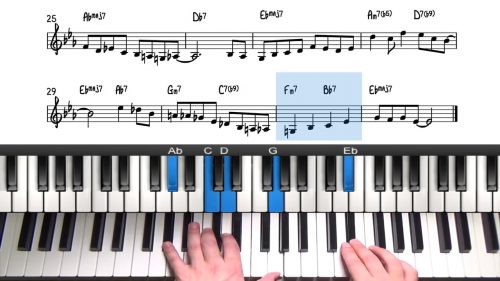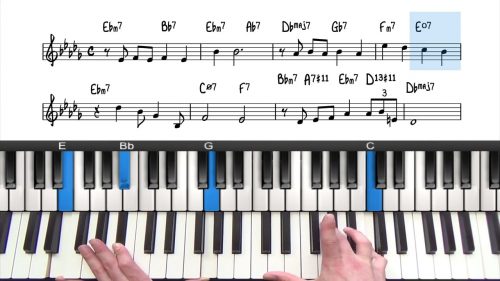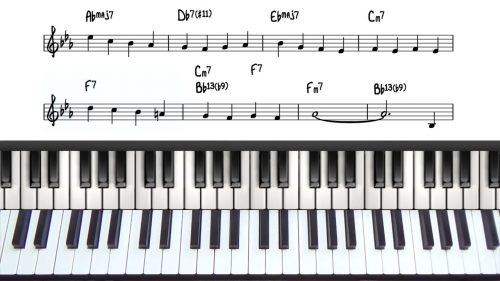Diminished Chords & The Minor 3rd Relationship
Welcome to lesson 5 of this course on Advanced Harmonic Concepts. In this lesson, we will explore the diminished chord, and how it connects 4 different dominant 7th chords.
Diminished chords often function as a rootless dominant b9 as illustrated in the examples. Another function is to act as a tension of the tonic, for example, Cdim7 to Cmaj7.
For the purpose of this lesson, we will explore the diminished chord as a rootless dominant b9 chord and analyse the 4 related dominants.
The 4 Related Dominant Chords
Each diminished chord can function as 4 different dominant b9 chords. The roots of these dominants also create another diminished chord. Furthermore, any of these dominant chords can resolve to any of the tonics that they are related.
We have already covered 3 of these dominants:
- D-7 –> G7 –> Cmaj7 (regular dominant colour)
- F-7 –> Bb7 –> Cmaj7 (minor 25 colour )
- Ab-7 –> Db7 –> Cmaj7 (tritone sub colour)
And here is the final, new dominant relationship:
- B-7 —> E7 –> Cmaj7 (relative minor colour)
As an exercise, you should find and play these 4 related dominant chords for all 12 keys.
Apply The Melody For All 4 Related Dominants
We now have 4 ways to apply the melody for any 251 progression. Each application will give you a unique colour over the underlying harmony. We will demonstrate in the key of C to illustrate the 4 melody applications that can be used over any 251 progression.
You should take this exercise around all 12 keys. You should find this exercise straight-forward as you are repeating the earlier exercises from this course. This exercise incorporates all 4 related dominants and so you will begin to see the ‘bigger picture’.
The final step is to play the new melody application over all of the 25s in “There Will Never Be Another You”.
Practice Tips
-
After completing the exercises outlined in this lesson, you should begin to see how all of the previous applications are related.
-
This final application is far from the original harmony, and so if you decide to use this sound, use it carefully.
-
You can work on this whilst away from the piano. As outlined in this video, try to work out the 4 related dominant to any tonic.
-
There are many ways to visualise this relationship, and so find what works best for you.







At 5’55”, the “second dominant” which is the minor 251 should be Bmi7-E7-Ami7 or Cmaj for this exercise (Ami being the related key to Cmaj). Fmi – Bb7 should go to EbMaj which is related to key of Cmi ? Or am I missing something?
Please ignore this comment. I have just understood what you are saying.